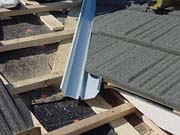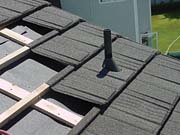Stone-coated Steel Roofing: One Company's Approach to Training


There is an array of products to choose from: from shakes to shingles, to metal and composite, each manufacturer contributes a unique option for today's home and building owner. Although the roofing options can vary drastically in color, texture, shape and size, one thing remains the same: The roof needs to be installed correctly.
Thus when roofing contractors are ready to expand their product line, it is critical that they take the time to learn the proper installation of the product. "Many contractors think that if it goes on the roof their crews can apply it," says Tom Sands, regional manager for DECRA Roofing Systems. "Unfortunately that is not always the case, especially with newer, non-traditional roofing products."
An example of this is the growth in popularity of stone-coated steel roofing. Some of DECRA's profiles are installed using a batten system that can often be installed over the existing roof. This feature not only allows for increased ventilation space between the new roof and the existing roof, but also saves the homeowner money since a tear-off of the old roof is not necessary. Beyond the cost savings, it also offers environmental benefits since the old roof does not end up in a landfill.
"Although the installation of stone-coated steel is different, it offers huge benefits," continues Sands. "New and non-traditional steep-slope roofing products are offering contractors new opportunities in their sales possibilities."
Another key to using different products is the possibility of cost savings in production. The larger size and lighter weight of the stone-coated steel panels compared to the smaller traditional roofing materials, saves time during installation. Also, roofing products that utilize a batten system often can go over the existing roof, eliminating the time and mess of a tear-off.
Bill Sharp, president of Sharp Roofing Systems in Arlington, Texas, has over 16 years of experience installing stone-coated steel roofing systems. "It's important that contractors understand not only correct installation methods, but also the benefits of the product," he says. "We have been able to sell the stone-coated steel shingles using the fact that they are lightweight, (weighing only 1.25 lbs. per square foot) and very durable including Class 4 impact resistance and Class A fire resistance."
Proper installation training can prevent other damaging factors such as carelessness. "Contractors sometimes try to finish a job faster by cutting corners," says Sharp. "For instance, with stone-coated steel roofing products, it is important that tiles are staggered so the seams do not intersect with each other." Using this technique will ensure the strength of the product.
In an effort to increase the knowledge of stone-coated steel roofing systems, DECRA offers a variety of installation training tools. "You can have the right product, but if you don't have a trained professional to install it, the roof will not function properly," Sands notes. The company conducts installation-training seminars throughout the United States and Canada. The seminars include training contractors and distributors on how to install its products, how to utilize its accessories and tools, and how to estimate the amount of necessary accessory pieces and panels.
As with other steep-slope roofing manufacturers, DECRA believes in training from the ground up. The company starts with proper deck preparation for both new construction and reroof installations with an emphasis on understanding local building codes.
Although the suggested installation methods provided in the installation guides, video and seminars are easy to understand, Mike Twedell, a DECRA zone manager often visits job sites of new contractors on the first day of installation. "We conduct quality control and also refer new contractors to experienced crews," says Twedell. "Crews that have the proper tools and knowledge of the product and its application methods, provide a quality installation."
As noted, in addition to installation training in the United States, DECRA also offers training programs in Canada. The board of directors and members of the Roofing Contractor's Association of British Columbia recently selected Wayne Bryson, DECRA regional manager, as the 2003 recipient of the Stan Gregorowich Memorial Award for Exceptional Contributions to Education. Bryson has participated in several roofing symposiums and has experience training roofing contractors on stone-coated steel roofing product installation. Bryson has worked extensively with architects, designers and engineers on developing this type of roofing application. He has continually worked to educate the industry about the benefits of metal roofing. He has also conducted job site and classroom training sessions throughout Western Canada.
Aside from job site and seminar training, DECRA also offers product information on its Web site. Here contractors can find step-by-step installation training guides for all of the company's profiles along with product information, technical information, specifications and color charts.
"We have different training tools to accommodate our customers," agrees Paul Sadosky, regional manager, who has trained more than 30 contractors on how to install the company's product. "It has really served our contractors well. Allowing them to not only grow their business, but also to maintain an excellent reputation of craftsmanship."
Finding a reputable product to add to your company's product line is crucial in today's economy, but correct installation of that new product is just as important. To ensure proper installation training, get assistance from a trained representative in your area. Your businesses growth potential and reputation depend on the decisions you make about new product additions and training.
Looking for a reprint of this article?
From high-res PDFs to custom plaques, order your copy today!





